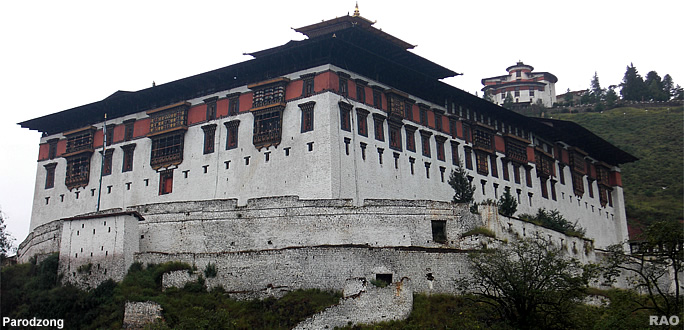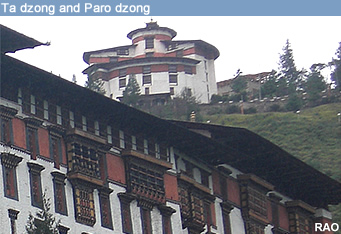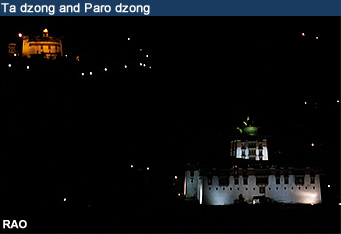 |
Bhutan's Culture Dzongs |
|
 |
Bhutan Information |
|
|
 |
| Paro Ta dzong |
 |
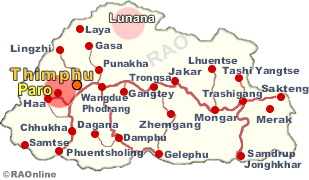 |
|
Paro Ta dzong : «The 19th century 'horse egg', considered one of national museum's most precious objects was gifted to the museum in 1969. Made of an unknown substance, the egg is believed to have originated from a horse in Trashiyangtse. National museum director Khenpo Phuntsok Tashi said it may have been a result of excess salt consumption by the horse, or it could be a fossil. "Those days, anything was possible,"he said.
|
|
The National Museum: One of Paro's major tourist attractions, the national museum's Ta dzong will re-open only in 2015.
The structure suffered major damage in the Sept. 2011 earthquake
Ta dzong suffered major structural damage during earthquake, rendering it inaccessible to the public for safety reasons.
The national museum director, Khenpo Phuntsok Tashi, said that renovations are scheduled to begin shortly after structural drawings and other required documentation are completed in April.
|
|
More than half of the exhibits from Ta dzong, are now displayed in a two-storey building located above it.
He pointed out that Ta dzong, once restored, will be equipped with modern facilities, similar to popular museums abroad.This should not only prolong the life of the museum's exhibits, but of the building itself.
He said that the museum's security would also receive a major upgrade, with installation of CCTV and metal detectors, among others.
A route to cater to the physically challenged, that would connect all seven floors of Ta dzong, is also being seriously considered.
Khenpo Phuntsok Tashi said that, while it is a highly appropriate time to renovate and restore Ta dzong, it is unfortunate that locals and tourists will not be able to enter the structure until 2015.He said that the structure is itself an "art object".
With seven floors the cylindrical building with tapering walls is one of Bhutan's more unique architectural structures.
|
|
Khenpo Phuntsok Tashi also explained that Ta dzong is a "living museum", in the sense that locals can visit and pay respect to objects displayed through prostrations, prayer, and offering of flowers and incense.
Khenpo Phuntsok Tashi said that, while the pre-history and contemporary art exhibitions are in storage, the "star" attractions of the museum, like the horse egg and horn, a 12th century arrow head supposed to belong to one of king Gesar's generals, and a 1,000-year old statue, remain available for public viewing.
Besides current exhibitions on thangkas, ritual dance masks, and arms and armour, the national museum will also be adding a natural history exhibition, showcasing Bhutan's animal and insect biodiversity in November.The exhibition, funded by DANIDA, will be enhanced through touch screens and audio availability, to provide a sense of realism, said khenpo Phuntsok Tashi.
Some long-term plans include a tribal history exhibition, a botanical garden, and purchasable replicas of art objects.
Construction of Ta dzong began in 1649 by Paro penlop Tenzin Drukdra, who was also the half brother of Zhabdrung Ngawang Namgyel, explained khenpo Phuntsok Tashi.
Ta dzong was completed in 1651, and served as an outpost and watch tower for Tibetan invasion forces.
In the 1960s, Ta dzong was renovated and converted into a museum.
 |
| Contributed by
Gyalsten K Dorji, Kuensel, Bhutan's National Newspaper 2012 |
|
Guardian of the dzong |

|
 |
|
Paro Tshechu: Amongst the thousands attending the Paro tshechu is soft-spoken Pem Dorji, who wears a smile on his weathered face.
He is neither a gup nor a senior government official, yet he wears the gup's kabney, and dangles a patang (sword) from the right side of his waist.In his hand he holds a whip made of cowhide. |
|
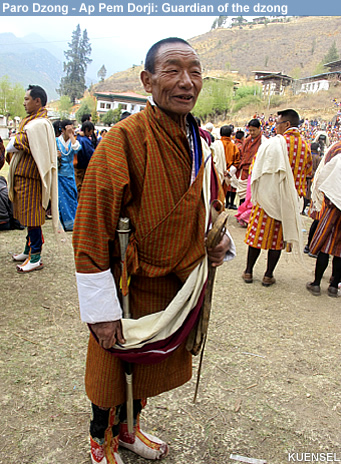
|
|
A few call him Dasho Khangnyerp, a title originating from the time of Zhabdrung Ngawang Namgyal.Khangnyerliterally means watchman appointed for guarding dzongs.
The legacy of khangnyer still prevails in Paro dzong, and he demonstrates his role during the annual tshechu.
Had he been in the civil service, Pem would have retired, but the 67-year-old is still serving the dzongkhag ever since his appointment in 1996.As a khangnyer, he has been controlling the crowd for the past 16 years.These days, he helps manage the crowd, together with the police.
But he senses that his watchman days may be over. "My role is on the verge of ending," he said laughing. "I no longer have to look after the crowd, as much as I did in those days."Today, he coordinates the preparatory work, especially during tshechu, and informs mask dancers about meal times.
Former Paro dzongda Lam Rinzin, 85, explained that, during the time of Zhabdrung, khangnyers served as the gatekeeper of the Dzong.
|
|
They made calls before dark, alerting people to put off the lights. "If lighting wasn't cared for, it could endanger the dzong," Lam Rinzin said.
The khangnyer lived in a small house attached to the main gate of the Dzong. "Those days khangnyer was so powerful that all gups of Bakor Tsoduk, in present day 10 gewogs of the dzongkhag, had to listen and abide by his order," Lam Rinzin said. "He supervised and controlled them."
Many said that khangnyers were so powerful that they used the whip on people, who did not listen. Goenpo, 53, remembers one of the khangnyers beating him during a tshechu. "I can vividly recollect a watchman raising hands on me when I was a child," he said.Dzongkhag culture officer Karma Dorji also recollectskhangnyers beating people. "Khangyners were powerful," he said.
Khangyer Pem Dorji said that he might have beaten more than 1,000 people in the line of duty. "I beat those, who were undisciplined and disturbing public occasions."According to him, people held the post of khangnyer only after serving many years in the dzong.But he was a soldier before assuming the post.
Pem Dorji says the patang represents his role in the civil administration, and the four-foot long whip indicates his service to the clergy.
As part of his service to the clergy, he would collect religious items for performing major rituals.But the most difficult task was collecting donkey's urine. "We had to wait for long hours, as the donkey wouldn't urinate in our presence," he said.
The urine was required when wrathful ceremonieswere performed.Even today, he acts as a messenger between administration and rabdey.He also assists caretakers of the lhakhangs in collecting water for morning choep (water offering)
On the administration part, he supervises elementary service personnel, who work to maintain cleanliness in and around the dzong premises.
Standing in one corner, Pem keeps a close watch over spectators, the whip in his left hand.During the morning chirdrel procession, he is in the front line, leading the group; and in the evening, he stands among dancers and participants to listen to the briefings and plans by a senior government official.
The father of five from Changnangkhar has only two days to showcase his role with patang and whip.When the tshechu's over on Friday, he has to hang them up and resume his daily work in the dzong. "I feel proud when I put on the sword," he said. "It's the sign of a hero."
 |
| Contributed by
Kuensel, Bhutan's National Newspaper |
top
| more
information |
 |
|



